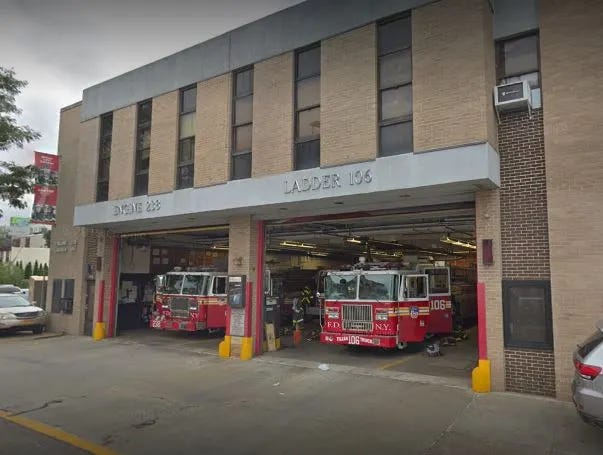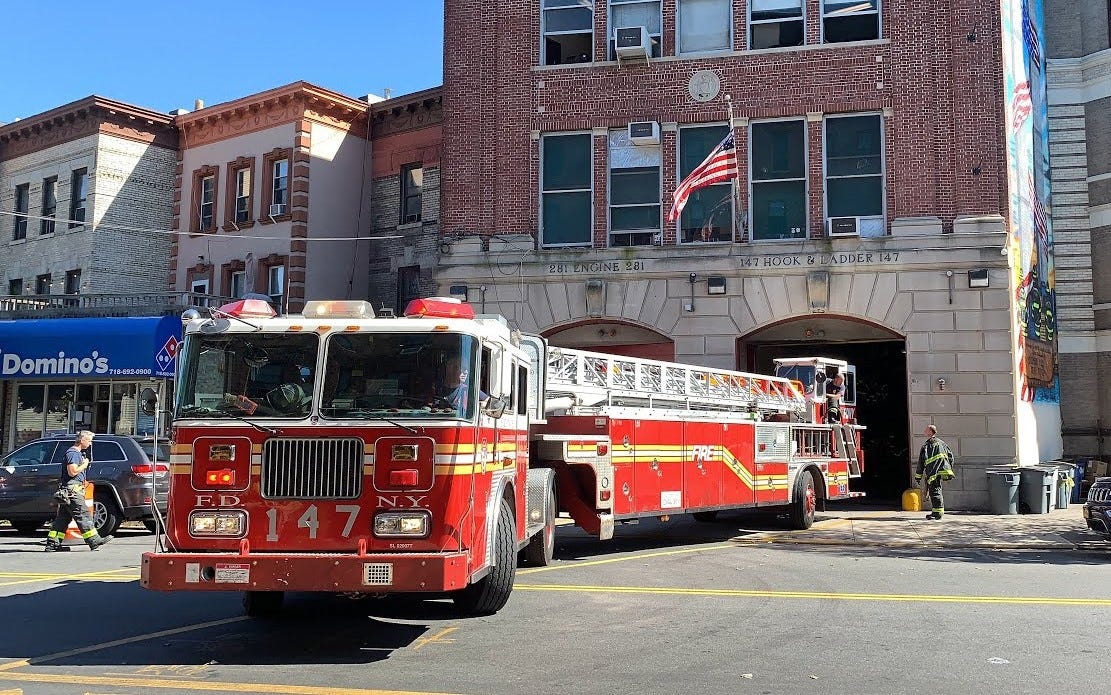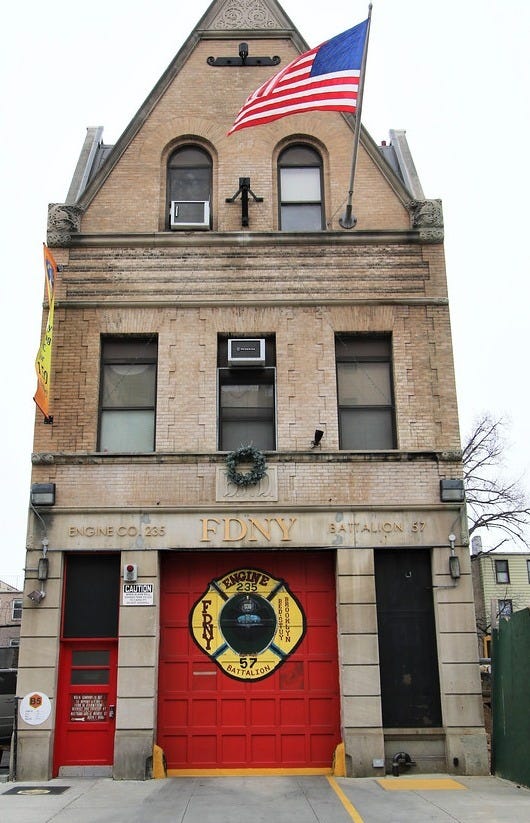The assignment was to hang out in the kitchens of a couple of firehouses around Brooklyn. The editor was not pleased when I said I didn’t want to. I wasn’t hired to be a food writer. I had pitched her a ton of feature stories and columns just the other day. One of the other reporters was clearly more intrigued by the prospect of hanging out with firefighters.
The editor wasn’t swayed. In any case, I was the only one in the newsroom with a car, even if it was an undependable wreck.
The FDNY approved three houses for me to visit. The department’s PR guy escorted me to the station and approved enough of my reporting methods to leave me alone. My editor later told me that the PR guy approved of me because I didn’t appear to be one of the those people with lascivious fantasies about firefighters. I didn’t even know that was a thing. This was the first detail I wrote on my pad.
It is no secret that firehouse cooks are superb. There’s mountains of cookbooks, cook-offs and community breakfasts and spaghetti feasts to attest to their skills. This is what happens when your work crams you together for what can be 24 hour shifts. They bond over a job that goes from mundane to dangerous in a matter of seconds. Eating around a common table is one of the best ways to foster comradery and confidence in one another. And the food better be good—loaded with nutrition and calories—not just because they need it to do their job to the fullest extend but because no one wants to be around dissatisfied firefighters.
The main cook at Engine 238 in Brooklyn’s Greenpoint neighborhood didn’t know I was coming so what he made that day was nothing special: thick slices of tomatoes from one of the men’s garden, topped sliced portobello mushrooms arranged over spinach for the appetizer, followed by a pork loin stuffed with gently sauteed apples, onions and mushrooms lightly doused with brandy and white wine right before being slid into the oven. The roast should take about 90 minutes or less to cook but a third of the way through alarms went off. The firefighters got up, less in a hurry than in a well orchestrated manner. The cook turned off the burners and oven and suited up after warning me to stay put in the kitchen. This was a good opportunity to open cupboards (family size bags of popcorn and potato chips and industrial-size cans of beans, tomato sauce, sacks of rice and flour). The cookware were all Revere because the manufacturer used to have a factory nearby. I could have helped myself to the tomato and mushroom appetizer but that seemed rude and the firefighters shouldn't come back to empty platters.
They returned fifteen minutes later—a false alarmed. The cook turned on the burners and oven. The firefighters resumed card games and conversations that even the most tense, such as the revelation that one of them was watching Bridgerton, were convivial. The pork finally came out of the oven, crusted and savory, juices running clear over roasted potatoes scattered about it. Nothing became more important than the passing of plates down the line until everyone had their fair share.
New York City’s fire department, established in 1848, is the oldest in the country. The oldest active firehouse in the city was built in 1865. Renovation and modernizing of the buildings depends upon the precarious health of the City’s finances. Most of the time, between caring for their equipment and vehicles, the firefighters accomplish the rehabs themselves out of their own money. The Flatbush neighborhood’s Engine 281, for instance, put a new kitchen into their 126 year old house. The kitchen now has a barreled ceiling paneled in tongue-in-grove rosewood, an exquisite exposed brick wall and a soft gray Mexican tile floor. The ancient City-issued stove was replaced by a Viking.
It wasn’t a large kitchen, barely able to fit its round table (also handmade) but there was an order to claiming seats. The first to arrive took the far chair by the stove, the last by the door. It was the one they reserved for me because I could only stay for lunch. Lucky me, it turned out to be two strombolis, one with a mixture of hot and sweet sausage, the other with ham, salami, and Swiss cheese. Just like everyone else, I asked for, and devoured, both. I continue to not being able to tell readers which one was better.
Off to Engine 235 where I received the secret to summer corn salad: always use fresh corn and LOTS of basil. Skimp first on the balsamic vinegar at first then add a little more as the salad mellows in the refrigerator. However, don’t let the salad mellow for too long or you’ll lose all the crunch of the ingredients.
235 turned out to be my favorite stop because they needed to go food shopping. This company maintains a strict rule about citizens not being allowed to remain unattended in the firehouse so I got to ride in a fire truck. I was handed a giant size jacket and pair of rubber boots then shuffled over to the truck where I lost one of the boots and almost slipped out of the coat while being hauled up into the cab. The only seat available in the tight space was on the lap of the firefighter nearest the door. We did our best to ignore how awkward this situation was, especially whenever the truck swerved around corners and he hugged me close to keep from falling against the door.
Driving a fire truck is like maneuvering a mammoth baby strollers through narrow streets. The advantage is people run out of your way—cars not so much—and you get to park anywhere no matter how much the drivers behind the truck shout obscenities out the window. Two firefighters jumped out at a vegetable stand. The rest of us parked in a towing zone and went into the market with a long list of ingredients for the evening’s meal. Fellow shoppers showed a great deal of courtesy when the men suddenly abandoned their carts and me in the middle of crowded aisle when they received calls to do God’s work of saving someone’s life. Engine 235 is in Bedford–Stuyvesant, with a little bit of East New York along its border, and considered one of the busiest in the city. Some days the firefighters never get anywhere near the checkout line and, instead, call a pizzeria near the station house for their standard order of as many toppings as possible, extra on the cheese.
We were lucky, though, and finished our shopping. The bags made the cab even smaller. Someone got me in their lap. He allowed me to smash into the door on the curves. Back at the station house, they hung their gear in their lockers and wandered into the kitchen. Preparation for the meal went fast because everyone took up a chore, as coordinated as I’d imagine they were out on the job. I stayed out of their way in the corner.
The captain came over and asked how my work was going. I said great and Engine 235 was the best of the bunch. He said write this down, could be something to stick for the ending:
“You know this job requires a lot of team work. You work together on the truck, in the kitchen, even the bunks—if the guy next to you is snoring to high heaven, you kick him for the rest of us.”
Station House 235 had a straight route to the World Trade Center on 9/11. They lost fove members.
Steven Bates, Lieutenant
Nicholas Chiofalo, Firefighter
Francis Esposito, Firefighter
Lee Fehling, Firefighter
Lawrence Veling, Firefighter







Wonderful story—poignant and perfect for this date. Thanks for sharing it.
Wonderful. What a fun assignment and a poignant memory for today.